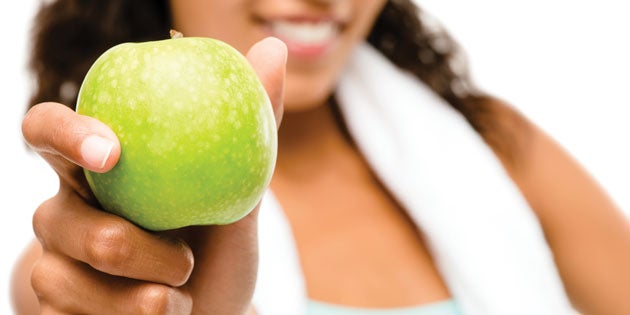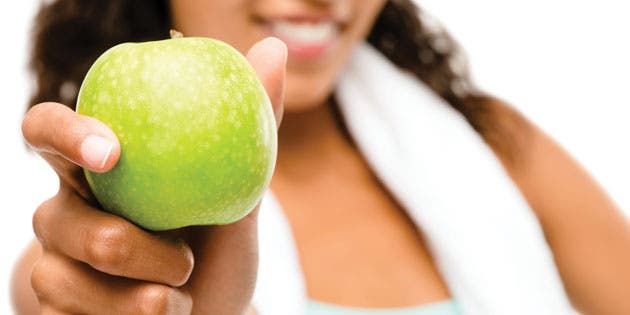Chew Your Way Slim


Are you a speed eater? If you’re wolfing down your food as you fly out the door, you could be canceling out your clean-eating efforts. Research published in the January 2014 Journal of the Academy of Nutrition and Dietetics illustrated that you eat fewer calories per meal when you eat slowly. In the study, overweight as well as normal-weight subjects consumed fewer calories when they ate at a leisurely pace as compared to when they ate quickly. Another study, this one published a few months earlier in the same journal, found that the number of chews taken before swallowing reduced food intake in people of all sizes. The researchers noted that people of average weight in general chewed more slowly compared to their supersized counterparts.
Fare Blunder #1: Chowing down in front of the TV or at the computer
Are you prone to inhaling the popcorn before The Big Bang Theory theme music even starts or downing lunch at your desk? Whether you work through your lunch break or eat in front of the TV, chances are you pay closer attention to what’s on the screen than what’s on your plate — and how fast you eat it. Lunching in front of your monitor may also lead to overeating later on, according to a study from the University of Bristol, in which the participants who focused on the screen more than their meals felt less satisfied with what they ate, making them more likely to indulge in sweets later in the day.
Fare Fix #1: Plan a lunch date
At least twice a week, get out of the office at mealtime. Make lunch plans with co-workers (as long as it’s not fast food) or with yourself (take your brown bag to a park bench where you can unwind and follow up with a refreshing walk). Research suggests that our fat-burning potential declines the longer we sit, so get off your swivel seat and seek out better scenery.
Fare Blunder #2: Juggling meals behind the wheel
You’ve probably scarfed down a quick breakfast while racing to work at least once in your life. In fact, an estimated 20 percent of all American meals are eaten in the car. Although eating behind the wheel may save you time, it’s hard to watch the road and your calorie intake at the same time. Worse still, it may do more than just damage your diet. A British study that used driving simulators showed that drinking or eating while driving is almost as dangerous as talking on a cell phone.
Fare Fix #2: Dashing after dining
Prep easy meals and keep them in the fridge for those hectic days. If you know you’ll need to dine and dash at lunchtime, wraps with turkey and avocado, or chopped veggies and hard-boiled eggs are ideal. If breakfast is your biggest challenge, combine ⅓ cup rolled oats + ⅓ cup skim milk + ⅓ cup Greek yogurt + ½ mashed banana. Mix it up in a jar and leave in the fridge overnight. In the morning, top the mixture with almonds or flaxseed. Add whey powder for extra protein, if desired.
Fare Blunder #3: Omitting snacks between meals
It may seem counterintuitive to add snacks to your food plan if you want to stay slim, but if you wait too long between meals, you’ll be famished by the time you sit down to nosh, making you more likely to eat a lot — and quickly. Slow snacking may actually keep you slim. A recent study on Spanish teens found that not only did those who ate regular morning and afternoon snacks tend to have lower body-fat levels than their counterparts, those who ate more slowly — which is easier to do when you’re not ravenous — were also more likely to be leaner, too.
Fare Fix #3: Nuts keep you sane
Nuts and seeds, such as almonds and pumpkin seeds (a top source of iron), make great choices for no-mess snacks because they contain healthy fats that elevate levels of cholecystokinin, or CCK, an appetite-suppressing hormone. Keep a stash of these nutrition-packed nuggets on hand for grabbing between meetings or on your way out the door.
Fare Blunder #4: Going to the gym after hitting the junk food
Is this your usual drill? You’re heading for the gym for a tough workout when you hear a rumble in your tummy telling you to fuel up first. That’s when you scarf down a calorie-laden coffee-shop muffin or make a quick stop at the drive-through, leaving you bloated instead of energized.
Fare Fix #4: Stick to a preworkout plan
Try to hit the gym at approximately the same time every day. To make the most of your workouts while keeping your cravings at bay, have a meal that includes a source of protein and slow-burning carbohydrates one to three hours before you hit the gym. Some easy examples include Greek yogurt with berries and low-fat granola, a hard-boiled egg and whole-grain pita, or peanut or almond butter on a banana. The protein will help suppress your appetite, while the carbs provide crucial fuel to power your workout.
Fare Blunder #5: Drinking too fast
You want to stay hydrated, but even drinking plain water or other fluids too quickly can lead to stomach discomfort, burping or acid reflux, in which an overload of fluid causes acid to spill back up the esophagus. And if you drink alcohol too quickly, your body can’t process it fast enough. In that case, you’re likely to consume more than you will be able to handle without doing some damage to your liver. And remember, women tend to process alcohol differently than men.
Fare Fix #5: Eat up!
Eat a small meal before you plan to drink and alternate the alcohol with nonalcoholic beverages. That will slow the absorption rate of the ethanol into your bloodstream.